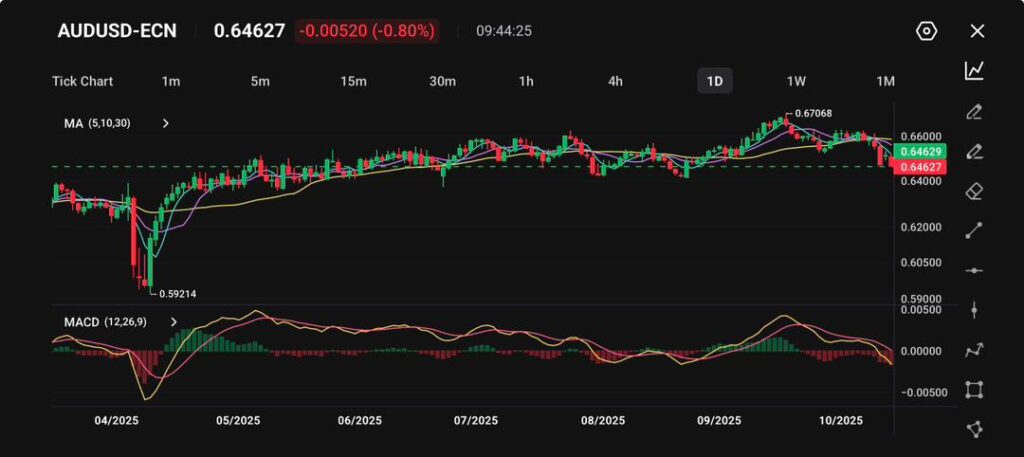
Key Points
- AUD/USD fell below 0.651, marking its weakest level in over a month.
- China’s new sanctions reignite trade tensions, weighing on risk appetite.
The Australian dollar fell sharply on Tuesday, slipping past $0.651 to its lowest level in more than a month as renewed trade tensions between the United States and China dented global risk sentiment.
China announced sanctions on five US-affiliated subsidiaries of South Korean shipbuilder Hanwha Ocean, escalating trade frictions with Washington. The move followed a series of tit-for-tat measures, including reciprocal port fees imposed by both countries, though Beijing exempted domestically built vessels from the new charges.
Markets reacted cautiously, with traders trimming exposure to risk-sensitive assets such as the Australian dollar, which is often seen as a proxy for China’s economic outlook.
RBA Minutes Show Cautious Tone
On the monetary policy front, minutes from the Reserve Bank of Australia’s (RBA) October meeting reinforced expectations that the central bank will remain patient. Policymakers noted there was no immediate need for further interest rate adjustments, but reiterated that future decisions will depend on the data.
The RBA’s cautious tone suggests it will continue monitoring inflation and labour market trends closely before taking any additional steps. The next policy meeting in November will be watched for any signal of a shift in stance.
Domestic Data Offers Limited Support
Adding a small bright spot, Australia’s NAB Business Confidence Index rose to 7 in September, recovering from a three-month low of 4 in August and remaining above its long-term average. The improvement reflected stronger business conditions, although the currency failed to capitalise on the data amid broader market pressures.
Technical Analysis
The AUD/USD pair is trading around 0.6463, down sharply by 0.80%, as risk sentiment turns sour and the U.S. dollar extends its broad rally. The Australian dollar continues to weaken amid softer commodity prices, cautious tones from the Reserve Bank of Australia (RBA), and lingering concerns about China’s sluggish recovery — a key driver of Australian exports.
From a technical perspective, AUD/USD is showing a clear bearish reversal. The pair has fallen below all key moving averages (5-, 10-, and 30-day), confirming short-term downward momentum.

The recent breakdown from the 0.6500–0.6520 support area has opened the way toward the 0.6400 psychological level, with further downside risk toward 0.6320 if bearish momentum accelerates.
The MACD is deepening in negative territory, with a widening gap between the signal and MACD lines, an indicator of intensifying downside pressure. Momentum remains firmly in favour of sellers, and unless price recovers above 0.6550, rallies are likely to be sold into.
On the fundamental front, the RBA’s recent statements highlighting a cautious stance on rate adjustments, coupled with subdued wage growth and falling iron ore prices, have weighed heavily on the Aussie.
Immediate support lies around 0.645, followed by 0.640, while resistance is seen near 0.656. A sustained break below current levels could expose the next downside target near 0.635, marking a potential retracement of the August uptrend.
Outlook
The near-term outlook for the Australian dollar remains subdued as external headwinds dominate sentiment. While domestic fundamentals appear stable, the escalation of US-China trade disputes and a data-dependent RBA stance are likely to keep the currency under pressure.







